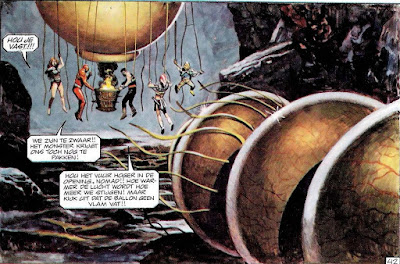Let's take a break from
Storm this week to look back at the mini-comic origins of the Masters of the Universe. I don't mean the 80s cartoon with a Captain Marvel in purple tights and a Prince Valiant haircut, a cowardly
lion tiger, and a moral for kiddies every episode. I mean the first, more pulpish, post-apocalyptic, sword & sorcery version--before even the 1982 DC comics limited-series. I mean the version appearing in the the four original mini-comics (though technically, these first four were picture books, not comics).
They were written by Donald Glut, who knew how to adapt Sword & Sorcery material for younger audiences with his comics work, including
Dagar the Invincible and
Tragg and the Sky Gods for Gold Key. Glut talks about the origins of some of the concepts in an
online interview. The evocative art for the four stories was by Alfredo Alcala, a comic book artist who's worked for DC and Marvel, on books like
Conan, and
Kull the Conqueror. What the two gave us was darker, moodier, and more streaked with pulpy highlights, than the decidedly brighter, more superhero-esque cartoon to follow. (I should point out all of the mini-comics are now available in a somewhat
larger tome.)
So without further ado, here's my commentary on the first mini-comic, 1981's
He-Man and The Power Sword:
We open with a bona fide Hero's Journey "Call to Adventure."
He-Man, greatest warrior of his primitve jungle tribe, leaves his people to go defend the legendary
Castle Grayskull ("a place of wonders") from the forces of evil. Instead of having a secret identity, He-Man is part of a proud (sometimes) barbaric lineage of Sword & Sorcery characters. He's got a nobler goal than Conan or Brak, but like those forebears he's fascinated by a wondrous elsewhere.
He-Man becomes the first of his people to "trudge the craggy cliffs and quake-torn valleys" outside of the jungle. It's not long before his courage and "jungle-bred stength" is needed. He sights a jade-skinned woman in a cobra headress fighting a purple monster that looks like it might be from a lost in space episode. He-Man rushes into the fray and despite the woman's mystical blasts ("She is a sorceress!" he thought), he pretty much does the monster slaying himself.
Had this not been a kid's book, the shapely
Sorceress might have rewarded the warrior other ways, but since it is, He-Man instead gets "Supernatural Aid" (again with the Hero's Journey!). The Sorceress gives him the treasures she's guarded all these years, things made "centuries before the Great War by Eternia's scientists."
Here's one of those cool details. We've got a Great (so great its capitalized) War, and scientists making medieval appearing weapons. One might wonder what kind of scientists those were, but this yarn provides hints but no answers.
He-Man takes the loot which includes a "strange vehicle" (understatement) that's "combination battering ram, catapult, and space-warp device." Those pre-Great War scientists did some out-of-the-box thinking.
Meanwhile,
Skeletor, and his minion
Beastman, and ogling the "warrior-goddess"
Tee-La (it was hyphenated in those early days) who's watering her "unicorn charger." The two villains attack, as Skeletor plans to make Tee-La his bride. We're told she
"fights like a demon, her body possessing the spirits of many ancestral champions," but Skeletor's energy blade wins the day.
They carry her with them to Castle Grayskull--"a fortress so ancient no one knew its origin." Over the objections of the Spirit of the castle, Skeletor forces open the Jaw-Bridge. Skeletor's after the other half of the Power Sword so that "
the magic fires, created by ancient scientists and sorcerers will blaze again." Cool.
It turns out Skeletor is from another dimension. The Great War ripped a whole in the walls between dimensions and threw him into Eternia. He plans to open another rift and bring through an army of conquest. This origin, of course, is ignored in later mini-comics and comics.
Elsewhere, He-Man is visited by
Man-At-Arms. What happens next is weird: "
'And what brings the famous Man At Arms to my humble house?' He-Man asked sarcastically." Why all the sarcasm, He-Man? Anyway, Man At Arms ("
whose people are the masters of all weapons") fills He-Man in on Skeletor's shenanigans. The two set out to stop him, with impulsive He-Man space-warping ahead.
Somehow, in the bowels of Grayskull (sold separately), Skeletor knows He-Man is coming and sends Beastman up to shoot the turrett laser at at him. Beastman proves surprising effective at this, and has He-Man down when the Man-At-Arms cavalry arrives to turn the tide. The He-Man makes the Jaw-Bridge open wide and the heroes head inside to find Tee-La.
Skeletor's had enough time to get the the Power Sword reunited. As the blade crackles with "green fire" he boasts: "
I am invincible. There is nothing I cannot do. Nothing!" The best use this power for is apparently making weapons come to life and fight He-Man.
At that moment, the Sorceress reappears glowing with
the same green energy as the power sword (Ah hah!). She chastises Skeletor for abusing power and splits the sword again. He-Man, Man-At-Arms, and the just freed Tee-La throw a beating on the two villains, but let 'em cry "mercy!" and run off (it's a kid's book, remember?). The Sorceress again hides the Power Sword and changes the lock on the castle.
"Do you think that's the last of those two or the Power Sword?" Man-At-Arms asks.
Do I really have to tell you He-Man's answer?
There you go, Great Wars, green Sorcereress, extradimensional portals, barbarian heroes, super-science, and sorcery. That's how it started.
























































